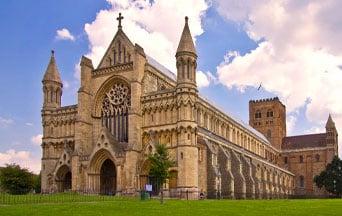
Many Catholics today are unaware of the immense contributions of the Ultramontanes of the nineteenth century to the resurgence of Catholicism worldwide. Prof. Fernando Furquim de Almeida (1913-1981) studied the movement and produced dozens of articles detailing the movement’s work. We have edited these articles and will be featuring them. They highlight the actions of ultramontane leaders in England, Spain, Italy, France and Ireland.
At the beginning of the nineteenth century, England was a mission country. Instead of regular dioceses, the Vatican divided Great Britain into eight apostolic vicariates. Fearing Protestant persecution, Catholics seemed incapable of manifesting their faith publicly and lived in hiding. The existence of the Catholic Church in England consisted of only a few small groups that gathered around apostolic vicars or nobles who remained Catholic.
Charles Januarius Cardinal Acton, a curial cardinal, maintained British ecclesiastical tradition in Rome. However, he always recommended caution to avoid clashes with heretics. Thus, he did not contribute to the revival of Catholic life in his country.
Catholic Emancipation
The early work of reviving Catholicism in Great Britain started with an Irish politician, Daniel O’Connell.1 His tireless activity, struggles, and splendid victories stirred Catholic opinion in England and lifted it out of its inertia.
Surprised, English Catholics watched people across the country discuss the legal status of the Church. They were shocked at O’Connell’s success and the progress of the Irish movement. They reluctantly felt obliged to fight in defense of their principles.
Eternal and Natural Law: The Foundation of Morals and Law
An unexpected reinforcement gave them a new lease on life. Attracted by the industrialization that provided England with great material prosperity, Irish immigration grew steadily and considerably from the beginning of the century. This trend peaked in 1845 when a terrible famine struck Ireland. The Irish brought an awareness of their rights and enthusiasm to fight under O’Connell’s orders. They were like new blood injected into the veins of English Catholicism. New parishes were founded, Catholic life began to manifest itself publicly, and the apostolate received a strong impetus. All this opened up new prospects for the future of the Church in England.
The Birth of the Oxford Movement
The Protestant reaction was not long in coming. In 1833, as the government suppressed part of Ireland’s Protestant bishoprics, Pastor John Keble delivered a sermon against “national apostasy.” In it, Keble ardently appealed to Anglicans to unite against clerical inertia. He proposed the idea that “high church” Anglicanism could reform the Church of England by adopting some aspects of Catholic worship. In turn, this would make Anglicans capable of halting the progress of “papism” in the country. One can say that sermon marked the beginning of the famous Oxford Movement.
 Learn All About the Prophecies of Our Lady of Good Success About Our Times
Learn All About the Prophecies of Our Lady of Good Success About Our Times
From the beginning, the Oxford Movement represented the highest cultural levels in the nation. University students and clerics of superior intellectual caliber devoted themselves to it, body and soul. Many of its members’ good faith foreshadowed the later conversions in its midst.
Nicholas Wiseman
At the same time, a young priest, Fr. Nicholas Wiseman (later Cardinal Wiseman), felt inspired to dedicate himself entirely to restoring Catholicism in his homeland. In 1824, aged 22, he obtained a doctorate in theology at the English College in Rome, which had reopened in 1818. Intelligent and greatly inclined toward biblical studies, he devoted himself to them and oriental languages. His was a rapid career: in 1827, he was appointed vice-chancellor and, a year later, rector of the English College.
The O’Connell movement and the progress of Catholicism in England vividly impressed the young professor. In 1833, upon receiving a visit from Lord Spencer’s son, a convert, he realized the possibilities of the Catholic Church in his country. Later, he was visited by Richard Froude and John Henry Newman, leaders of the Oxford Movement, who were then also considering conversion to the true Faith. He decided to exchange his strictly intellectual life for an active apostolate in England.
Before returning to his homeland, Fr. Wiseman visited France, where he saw a thriving Catholic movement emerging from the ashes of the French Revolution and Napoleon’s empire. As soon as he arrived in London, he began the magnificent work that led to re-establishing the ecclesiastical hierarchy in the country and the conversion of numerous intellectuals from the Oxford Movement.
The Rise of Ultramontanism
Fr. Henry Edward Manning, one of the Oxford Movement converts, later provided momentum for the English Catholic movement and one of the outstanding achievements of the nineteenth century: Ultramontanism.
Science Confirms: Angels Took the House of Our Lady of Nazareth to Loreto
That movement began with a series of talks under the general title of “Lectures,” expounding the principles of the true Religion. Organized along the lines of the Lacordaire Lectures in Paris, they were very successful. Thanks to them, Catholics gradually regained citizenship rights.
In his indefatigable zeal, Fr. Wiseman was not content with such brilliant results. Putting aside all prejudices generated by the clashing orientations of Irish and English during the struggle for emancipation, he founded the Dublin Review with O’Connell. The Review became one of the mainstays of the Anglo-Irish Catholic movement. Later, led by William George Ward (another convert from the Oxford Movement), it energetically defended papal infallibility.
English Catholicism certainly owes much to Irish immigration and the conversions of those in the Oxford Movement. However, Father Wiseman forged its definitive characteristics by guiding its initial steps and early campaigns. He undoubtedly deserves the title of founder of the English Catholic movement.
Photo Credit: © DazGee – stock.adobe.com

